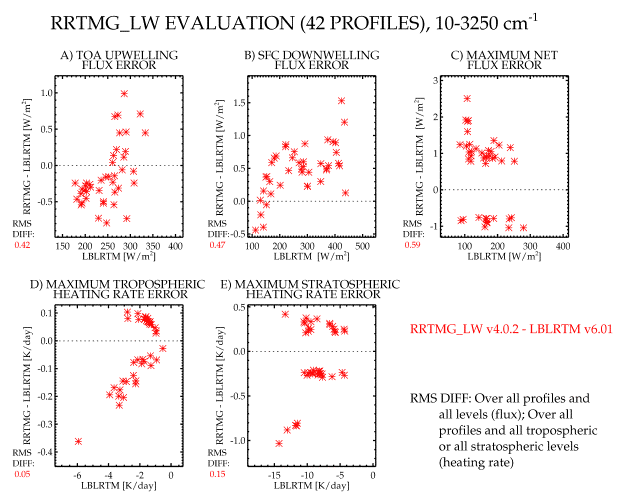-
Notifications
You must be signed in to change notification settings - Fork 9
Description
Rick Pernak edited this page Mar 20, 2020
·
6 revisions
RRTMG_LW is a radiative transfer model that utilizes the correlated-k approach to calculate longwave fluxes and heating rates efficiently and accurately for application to GCMs.
Key features of RRTMG_LW are:
- Absorption coefficient data for the k-distributions are obtained directly from the line-by-line radiative transfer model, LBLRTM, which has been extensively validated against observations, principally at the ARM SGP site. Data are consistent with those used in RRTM_LW_v3.0.1, which is described on its RTWeb site, and differences between RRTMG and RRTM have their own Wiki page.
- Fluxes and heating rates can be calculated over sixteen contiguous bands in the longwave (10-3250 cm-1, or 3.08-1000 microns). The individual band ranges (in wavenumbers, cm-1) are:
- 10-350
- 350-500
- 500-630
- 630-700
- 700-820
- 820-980
- 980-1080
- 1080-1180
- 1180-1390
- 1390-1480
- 1480-1800
- 1800-2080
- 2080-2250
- 2250-2380
- 2380-2600
- 2600-3250.
- When results are integrated over the full longwave spectrum, the 2600-3250 cm-1 band includes a small adjustment to add the contribution over the spectral interval from 3250 cm-1 to infinity.
- Modeled molecular absorbers are water vapor, carbon dioxide, ozone, nitrous oxide, methane, oxygen, nitrogen and several halocarbons (CFC-11, CFC-12, CFC-22, and CCL4)
- Uses reduced set of g-intervals (140) for integration over absorption in each band relative to full set of g-intervals used in RRTM_LW (256)
- Includes McICA (Monte-Carlo Independant Column Approximation) capability to represent sub-grid cloud variability with random, maximum-random and maximum options for cloud overlap; References: Barker et al. (2003), Pincus et al., JGR, (2003)
- Performs radiative transfer for a single (diffusivity) angle (angle = 53 deg; secant angle = 1.66) and improves accuracy in profiles with high water by varying the angle in some bands as a function of total column water
- Coding has been reformatted to use many
FORTRAN90features - Model able to run either as a column model or as a callable subroutine
- Fluxes calculated by RRTMG_LW agree with those computed by LBLRTM within 1.0 W m-2 at all levels, and the computed cooling rates generally agree to within 0.1 K day-1 in the troposphere and 0.3 K day-1 in the stratosphere
- Water clouds:
- The optical properties of water clouds are calculated for each spectral band from the Hu and Stamnes parameterization. The optical depth, single-scattering albedo, and asymmetry parameter are parameterized as a function of cloud equivalent radius and liquid water path.
- Reference: Hu, Y. X., and K. Stamnes, An accurate parameterization of the radiative properties of water clouds suitable for use in climate models. J. Climate, Vol. 6, 728-742, 1993.
- Ice clouds:
- The optical properties of ice clouds are calculated for each spectral band from the Fu et al. ice particle parameterization.
- Reference: Fu, Yang, and Sun, J. Climate, Vol 11, 1998, pp. 2223-2237, 1998.
- Aerosols:
- Aerosol absorption in the longwave can be included by providing the bulk aerosol optical depth at the mid-point of each spectral band.
- Absorption coefficients and other initialization data can be optionally input through a netCDF data file. This feature was developed and provided by Patrick Hofmann and Robert Pincus of NOAA.
- An optional feature is available to calculate the change in upward flux by layer as a function of surface temperature. This can be used to approximate adjustments in upward flux caused only by a change in surface temperature in a GCM at time intervals between full radiation calls. This is derived using the pre-calculated derivative of the Planck function with respect to temperature.
